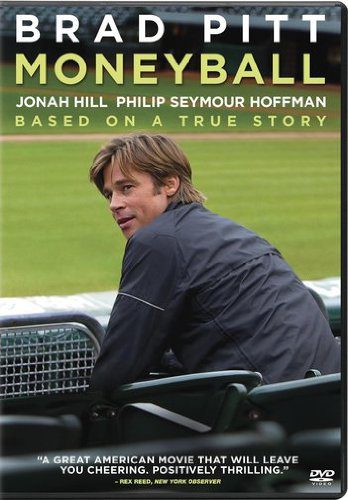 By Tolga Ozyurtcu
By Tolga Ozyurtcu
Although its subject is one of the more interesting moments in recent sports history, Moneyball offers surprisingly little of that history. The film opens with the disappointing end of the Oakland Athletics’ 2001 season, followed by General Manager Billy Beane’s (Brad Pitt) novel offseason rebuilding efforts and the team’s unexpected success in the 2002 season. The novelty at hand was Beane’s decision to abandon most of the traditional measures by which baseball scouts evaluated talent, replacing an old-guard of “lifer” baseball scouts and their obsession with traditional statistics, with economics-inspired, statistical models designed to find hidden value in baseball’s talent market. Beane’s shift to the new approach was driven by the inability of his small media market franchise to offer salaries to ballplayers that could compete with the big money, large market teams, like the New York Yankees.
While all of this is communicated reasonably well in Bennett Miller’s film, the casual viewer may be misled to think that Beane’s number-crunching approach was a twenty-first century innovation. What the film does not adequately address is the history of Sabermetrics, the name given to the general approach to baseball statistics that Beane and Paul DePodesta (or Peter Brand, as he was rechristened in the film, played by Jonah Hill) employed in revolutionizing the Oakland team and all of baseball. Sabermetrics are the brainchild of Bill James, a baseball historian, writer, and statistician who has been publishing on the subject since 1977. Through the late 1980s, James published the annual Bill James Baseball Abstract, focusing his efforts on the objective analysis of the sport through unique metrics like “runs created,” “range factor,” and “value over replacement player.” For James and other Sabermetricians, such measures allow for a level of quantitative analysis that links player performance with the production of wins for a team. From the Sabermetric perspective, traditional measures, such as batting average, are limited in that they only describe what a player does, without a useful measure of that player’s impact on the team. For example, while batting average is a traditional measure of the frequency of a player’s hits, James’ category of “runs created” factors in all of the ways a player can produce runs from an at-bat. For a team like Beane’s A’s, value could be found in passing on broadly appealing players with high batting averages, and focusing instead on players with high “runs created” ratings.
The Abstracts were popular with stat-obsessed fans and fantasy baseball aficionados, but James’ ideas failed to gain serious traction in mainstream baseball until the late 1990s, when Sandy Alderson, Beane’s predecessor as the Athletics General Manager began applying Sabermetric principles to identify undervalued players. Beane’s ascension saw the first significant deployment of the methods in the major leagues, with other teams embracing the approach following the Athletics’ success. The ultimate validation for James would arrive in 2003, when he was hired as a consultant by the Boston Red Sox, a position he still holds. Some fans and commentators credit James for some of the organizational and tactical decisions that led to the Red Sox winning their first World Series in 86 years, breaking the “Curse of the Bambino” in the process.
The James approach, especially as applied by Beane, is predicated on a simple idea: the talent market in baseball operates inefficiently due to poor evaluation criteria, resulting in the under-valuation of potentially productive players who can help teams win games. While the innovative exploitation of market conditions is a common capitalist endeavor, the insular, old world, and oligarchical nature of the professional sports business under-incentivizes the type of innovation Beane and DePodesta employed. American professional sports, perhaps more so than any other industry, revels in stable isomorphic practices and employs “tradition” as a bulwark against new approaches to management.
Beyond the standard limitations of the feature film format, Miller’s decision to gloss over this history underscores the point that the concept of “moneyball” is essentially a managerial perspective on resource allocation, while the film Moneyball is baseball movie. In other words, Miller’s film is about the reception of new ideas in the stubborn world of baseball, and less about the ideas themselves. This is probably a blessing for most viewers, who will be thankful to avoid the minutiae of Sabermetric analysis, but those interested in more detail on the subject can read Michael Lewis’ original book, Moneyball or take a look at the Society for American Baseball Research
What does make it to the screen is the rare sports film that is restrained in its use of genre stereotypes and still compels viewers to root for the underdog. Pitt plays Beane well, and Miller is mostly successful in portraying his protagonist as a contrary, but calculating risk taker, only occasionally slipping into sportsman-as-solitary-brooding-hero mode. Opposite Pitt, Phillip Seymour Hoffman plays beleaguered Athletics manager Art Howe, and it is a testament to Hoffman’s talent he somehow manages to elicit sympathy from the viewer while embodying the entire baseball establishment that Beane was up against.
In all, these performances and Miller’s subtle approach combine for a pleasurable film that is likely to have some appeal to viewers who do not normally enjoy sports films. Inevitably, some baseball aficionados will be disappointed with what was left out of the film, but most sports fans will appreciate the film and its celebration of a canny underdog.



